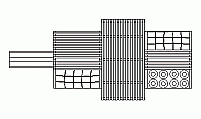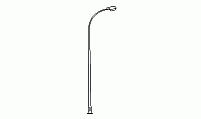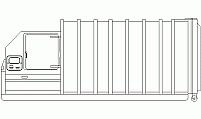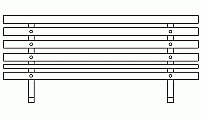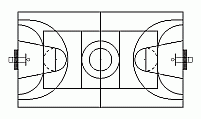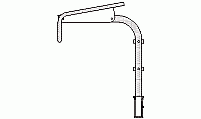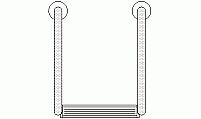CAD Blocks categories
 3D models
3D models home furniture
home furniture sanitary ware - bathrooms
sanitary ware - bathrooms professional equipment
professional equipment doors and windows
doors and windows people and animals
people and animals plants and trees
plants and trees vehicles - transports
vehicles - transports architectural details
architectural details mechanical - electrical
mechanical - electrical urban planning - civil works
urban planning - civil works safety health construction
safety health construction accessible design
accessible design drawing sheet
drawing sheet signals
signals construction machinery
construction machinery accessories and objects
accessories and objects maps and street maps
maps and street maps
Double-Arm Street Light Fixture CAD Block with Technical Details

size: 6 kb
category: street furniture
related categories:
description: This CAD block represents a double-arm street light fixture with two opposing luminaires mounted on a central pole for balanced illumination.
file extension: .dwg CAD - AutoCAD software
Detailed Insights on Design, Dimensions, and Safety for Public Lighting
Features and Design of Double-Arm Street Light Fixtures
Double-arm street light fixtures are widely used in urban and suburban areas to provide balanced illumination across roadways, pedestrian pathways, and public spaces. These fixtures consist of a central pole supporting two arms positioned longitudinally, each fitted with a luminaire to ensure even light distribution. The design minimizes shadows and enhances visibility for both pedestrians and vehicles, contributing to safer and more efficient traffic flow. These fixtures are typically made from durable materials such as galvanized steel, providing strength and resistance to environmental factors.
The height of the poles ranges from 20 to 40 feet (6 to 12 meters), depending on the application, whether for low-traffic areas or main roadways. The arms extend outward with a slight tilt, optimizing the angle of illumination. The entire structure is designed for durability and ease of maintenance, with modular components allowing for quick replacement of damaged parts. These fixtures comply with international safety standards, making them suitable for deployment in a variety of environments worldwide.
Dimensions and Technical Specifications
Double-arm street light fixtures are constructed with precise dimensions to ensure optimal performance and compatibility. Standard pole heights range from 20 to 40 feet (6 to 12 meters), with a top diameter of approximately 3.3 inches (85 mm) and a bottom diameter of 7.9 inches (200 mm). The pole wall thickness is generally 0.12 inches (3 mm), ensuring adequate structural strength to withstand environmental stresses such as wind and vibrations. The arms typically extend outward with an outreach of 2.6 to 3.3 feet (800 to 1000 mm), providing wide coverage.
The base plate, which secures the pole to the foundation, usually measures 15.7 x 15.7 inches (400 mm x 400 mm) and includes pre-drilled holes for anchor bolts. These bolts are typically 0.94 to 1.06 inches (24 to 27 mm) in diameter, depending on the height and weight of the pole. The luminaires are mounted at a tilt angle of 15 degrees, optimizing light dispersion. These dimensions adhere to global standards, ensuring compatibility and safety in diverse urban settings while maintaining high levels of efficiency and reliability.
Materials and Composition
The materials used in double-arm street light fixtures are selected for their durability, strength, and ability to withstand environmental factors. The poles are commonly made from galvanized steel or high-quality aluminum, both of which provide excellent resistance to corrosion and physical impact. The surface is treated with hot-dip galvanization, often followed by powder coating, to ensure a long-lasting and rust-proof finish. These treatments meet international Class II performance standards, ensuring the structure remains intact in challenging conditions.
The luminaires are housed in die-cast aluminum, which is lightweight yet robust, protecting the internal components from environmental exposure. The lenses are crafted from tempered glass, offering high transmittance and resistance to impact. LED modules are commonly used for their energy efficiency, brightness, and long operational lifespan, often exceeding 100,000 hours. Additionally, all external hardware, such as bolts and screws, is made from stainless steel to prevent corrosion and maintain the structural integrity of the fixture over time.
Safety Standards and Measures
Double-arm street light fixtures comply with rigorous international safety standards to ensure reliable and secure operation. They adhere to specifications such as IEC 60598 and other regional guidelines that regulate mechanical strength, electrical safety, and ingress protection. Poles are engineered to withstand wind speeds up to 100 mph (160 km/h), providing stability even in extreme weather conditions. The luminaires are typically rated IP66, ensuring complete protection against dust and water ingress, safeguarding the electrical components from environmental hazards.
Safety measures include proper grounding systems to dissipate electrical faults and prevent hazards. Each pole is equipped with an earthing connection point near the base. Additionally, circuit protection devices are integrated into the electrical system to prevent overloading and short circuits. These fixtures are subject to regular maintenance checks to ensure continued compliance with safety standards, particularly in high-traffic urban environments where reliability is critical for public safety.
Frequently Asked Questions
- What materials are used in double-arm street light fixtures?
- These fixtures are made from galvanized steel or aluminum for the poles and die-cast aluminum for the luminaires. The lenses are crafted from tempered glass, and all external hardware is stainless steel to ensure durability and resistance to corrosion.
- What are the standard dimensions for these fixtures?
- Poles range from 20 to 40 feet (6 to 12 meters) in height, with a top diameter of 3.3 inches (85 mm) and a bottom diameter of 7.9 inches (200 mm). The arms extend 2.6 to 3.3 feet (800 to 1000 mm) outward, and the base plate typically measures 15.7 x 15.7 inches (400 mm x 400 mm).
- How are these fixtures protected from environmental damage?
- Poles are treated with hot-dip galvanization and powder coating for rust resistance. Luminaires are rated IP66, ensuring protection against dust and water ingress, and are designed to withstand wind speeds of up to 100 mph (160 km/h).
- Why are LEDs commonly used in these fixtures?
- LED modules provide energy efficiency, high brightness, and long operational lifespans of over 100,000 hours. They reduce maintenance costs while ensuring reliable illumination for public spaces and roadways.
- What safety measures are implemented in these fixtures?
- Safety measures include grounding systems to prevent electrical faults, IP66-rated luminaires for water and dust protection, and compliance with international standards such as IEC 60598 to ensure reliability and performance.











